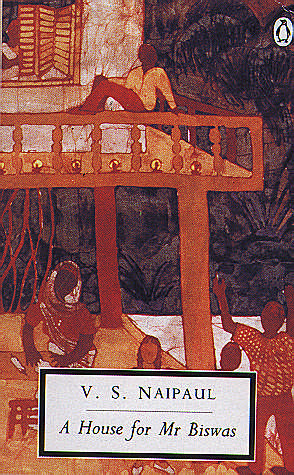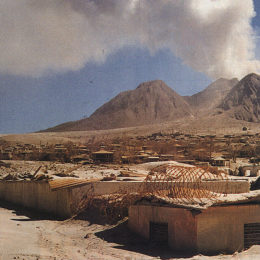Poor Mr Biswas. All the hero, or perhaps more accurately the anti-hero of V. S. Naipaul’s finest novel wants is his own house. Three times he succeeds in getting a place he can call his own. On each occasion it is a disaster. The first house collapses in a storm. The second is sold for lumber. The third is over-priced, rickety and beyond his modest means. Ironically, Mr Biswas does not even live there long before dying at the age of 46.
If it sounds like a sad story, then it is. Mr Biswas lives a short, mostly frustrated life, painfully conscious of his own many shortcomings and chronically anxious about the future. But it is by no means a tragedy (Biswas is too ordinary and much too annoying to lay claim to tragic status) and there is plenty of redeeming humour in the novel. In short, A House for Mr Biswas is a bitter-sweet chronicle of everyday failures and occasional triumphs which tells us as much about Naipaul himself as it does about colonial Trinidad.
House for Mr Biswas was Naipaul’s fourth novel, and followed three slighter, satirical works about Trinidad’s social and political life. All were published by André Deutsch in London, where Naipaul had been living since 1954, after taking a degree in English at Oxford. He had come to Britain in 1950, fulfilling a long-standing ambition to escape from Trinidad. In the fourth form at Queen’s Royal College in Port of Spain Naipaul inscribed in his Revised Latin Primer a vow to leave the island within five years. It took him six.
Naipaul is a notoriously private writer and has often rejected the view that his novels are autobiographical in inspiration. But from what we know of his early life in Trinidad, there is much to suggest that Mr Biswas in particular is not simply a figment of the imagination.
Naipaul’s father, Seepersad, was a journalist on the Trinidad Guardian and an aspiring writer of short stories. After a chequered career as a sign-writer, shopkeeper and plantation foreman, Mr Biswas becomes a journalist on the fictional Trinidad Sentinel. His forte is the quirky, sensationalist story, and his triumphs include an interview with Trinidad’s maddest man and the unforgettable headline “Daddy Comes Home in a Coffin”. But, like Naipaul’s father, Mr Biswas’s literary ambitions remain largely frustrated. A correspondence course with the Ideal School of Journalism in Edgware Road exhorts him to write pieces on such subjects as “Characters at the Local”, but his one story, entitled “Escape”, reads only: “At the age of thirty-three, when he was already the father of four children . . . ”
The novel’s principal theme of Indo-Trinidadian identity is also intimately related to Naipaul’s own early experience. His grandfather was a Brahmin from Uttar Pradesh, who indentured himself in order to teach among the island’s Indian sugar workers. Mr Biswas is also a Brahmin, even if his training to become a pundit ends in disaster. But it is his high-caste status which appeals to the Tulsis, the family which dominates the novel, and which brings him under the oppressive influence of “Tulsidom”.
The Tulsis are Naipaul’s archetype of Hindu Trinidad. High-caste, snobbish and commercially minded, they are a hugely extended family, headed by the all-powerful Mrs Tulsi. When Mr Biswas, at the time an itinerant sign-writer, makes a half-hearted pass at Shama, Mrs Tulsi’s daughter, he is quickly and unwillingly sucked into the clan. They live in Hanuman House, a huge and grotesque building, in which the Tulsi daughters, their husbands and hordes of children pay homage to the matriarch in an enclosed society which tries to turn its back on the outside world.
Mr Biswas is thus caught between the security and status which membership of this clan provides and a desperate desire to be free of its stifling influence. Successive attempts to break away end in humiliating failure and Mr Biswas is forced to endure the unwelcome intimacy of the extended family.
Yet, as Naipaul perceptively observes, the Tulsi family is vulnerable to the forces of social change in 1940s Trinidad. Religious and linguistic traditions come under strain as younger members of the family are exposed to outside influences at school and elsewhere. One son, Shekhar, marries a Canadian Presbyterian named Dorothy; another, Owad, goes to study in London and returns, claiming familiarity with T. S. Eliot and Picasso. The presence of American GIs in wartime Trinidad is another catalyst of social change. Govind, the former crab-catcher, becomes a taxi-driver in a shiny suit.
The gradual erosion of orthodox Hinduism and “Tulsidom” gives Mr Biswas the opportunity at last to cast off the family’s oppressive spell and claim his own long-overdue independence. This takes the form of a house, a place of his own — but he is sold a jerry-built wreck:
The very day the house was bought, they began to see flaws in it. The staircase was dangerous; the upper floor sagged; there was no back door; most of the windows didn’t close; one door could not open; the celotex panels under the eaves had fallen out and left gaps between which bats could enter the attic.
Like most things in Mr Biswas’s life (and, implicitly, in colonial Trinidad) it is a disappointment. Yet — and here Naipaul’s humanity briefly eclipses his cynicism — it is also his hero’s ultimate triumph, however flawed. For, finally, Mr Biswas owns a house, knows that his children have a future and can forget his nagging sense of rootlessness in his own ramshackle home. It is a small victory, to be sure, but at least Naipaul can conclude that “at the end everything seemed to grow bright.” His later books would not be so optimistic.
James Ferguson is the author of The Traveller’s Literary Companion to the Caribbean (In Print/Passport Books/Ian Randle Publishers)


















